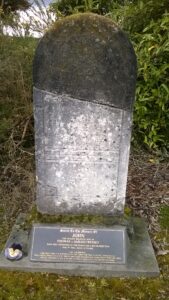1885: A Damning Epitaph
December 4, 2021
By AHNZ
Here is a grave stone in Ahaura Cemetry, West Coast, that tells a story for the generations. John Cressey had drowned in 1885 aged just 14 years, another victim of what our history often calls The New Zealand Death. In pioneering days, it is said, our people died so frequently of drownings that this term was apparently warranted. Long after the funeral, probably 20 years later1, John’s older brother Edward visited the grave yard in the dead of night to right some family wrongs.
With his young children holding the lanterns, John chiseled out the Bible verse that his own parents had inscribed on John’s tombstone. In deep, straight, cuts he obliterated what mother and father had etched in stone those many years ago. What Bible quote had incensed Edward for so many years that he risked a criminal offence for desecrating a grave? Fortunately, the grave provides the answer…
“Children obey your parents in the Lord for this is right. Ephesians 6-11”
WAS LATER CHISELED OFF BY JOHN’S BROTHER EDWARD ONE DARK NIGHT WITH HIS OWN YOUNG CHILDREN ELSIE AND TED HOLDING LIGHTS TO ILLUMINATE HIS TASK.
I think I understand why Edward did it for the memory of his brother. What a passive-aggressive, cold, high-minded, moralising thing for Mr and Mrs Cressey to include to the memory of their “dearly beloved” John! It’ as if Thomas Cressey, Senior, and his wife, Sarah,² had taken the opportunity to have the last word in a family argument with their deceased son now he couldn’t answer back. Rather than simply say goodbye to their boy the parents, in the name of the family, sent him to the afterlife chased by blame and fault. The epitaph may as well have been “I told you so.” It leaves a clear impression on me that Thomas, the Ahaura town butcher, was intent on vindicating himself publicly of all fault and placing judgement for the death onto the dead boy.
Edward, with his chisel, seems to have been of my point of view too. He didn’t want his brother’s eternal resting place used by their parents as a public advertisement of their exoneration and John’s disobedience. It seems as though Thomas and Sarah wanted the world to know that it was right that John should have drowned because he did not obey their (Godly, in the Lord, mind you!) edicts. It’s one thing to make a family Scapegoat of your dead son but it’s another to use a public gravestone to announce it to posterity. That, I think, is why Edward added his touch and made this one of the most interesting burial plots in New Zealand.
Also, this is a story about the so-called New Zealand Death. Having looked at the data I don’t think it’s true that it is a phenomena or the pioneering days at all. The recorded deaths, like that of Cressey, came after the first generation of pioneers. Another explanation for a boom in drowning deaths is that, as with Cressey, a case of inter-generational conflict. Ref. 1860s: The New Zealand Death.
—
1 Edward’s children were young but old enough to hold a lantern for Dad by 1905, 20 years after John’s dead; Ref. Geni
2 Update: Sarah, the mother, had already died before this epitaph was drafted. Ref. Geni, Ref. Christchurch City Libraries ArchivesSpace
Image ref. Grave of John Cressy, Ahaura Cemetry. AHNZ Archives (2020)
4 thoughts on "1885: A Damning Epitaph"
Leave a Reply
 Like Comment Share
Like Comment Share







Kia ora! I am one of the great grandchildren who with my cousins organised for the grave to be restored. We see the story as one about light. The text was put there by parents in great grief. Anger is part of that cycle. John was their eldest son who had run away from home to work for the butcher at Blacks Point. He was riding a pack horse delivering meat to a gold mine across the Inangahua when he was caught in a flash flood and drowned. The text on the grave stone could easily have been put there in love, to strongly discourage the others, (all under thirteen) not to follow suit. I doubt that John Cressey’s mother, Sarah, had much say, given that men were indisputably head of the family. Her story is a sad one. Her son Edward, my great grandfather with his own children rubbed out the offending text years later thus liberating his own progeny and serving his brother. To me this is a story about the power of love and healing through generations.. I’ll be coming down at Christmas to clear the moss from the top half. It spent a few years on the ground after vandals wrecked the cemetary in 1987. So I am following in my great grandfather’s footsteps of righting wrongs to this grave stone!
The porcelain pansy is there because that was my grandmother’s favourite flower.
The result of Johns untimely death was that the riding of laden pack horses was banned after a coronial enquiry.
Thank you for deepening the tale and I’ll make sure to include what you say.
In New Zealand grief is often mistaken for grief-avoidance.
I don’t think that my Great Grandmother , Sarah Cressey , would have written that epitaph about her son. I think she had died before John drowned but I maybe wrong.
Thank you. Nothing in paper on on BDM but if this genealogy is correct then you’re right. She was gone…
https://www.geni.com/people/Sarah-Cressey/6000000020239952828
I’ve struck out the text without deleting it and added a footnote with your correction. Irene Lister (1996) put a file together about all the 9 children which is in the Christchurch Library Archives; Might be informative.